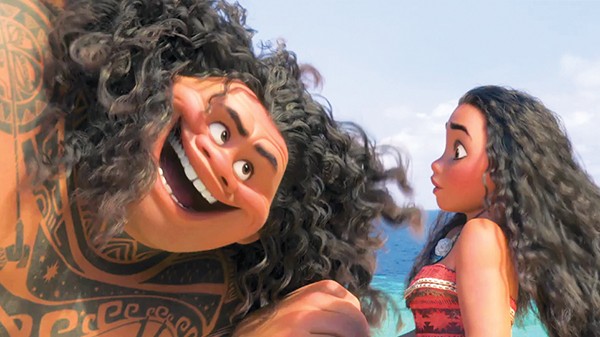Imagine my surprise when I discovered that Jumanji: Welcome to the Jungle is an adequately constructed, reasonably functional piece of entertainment. Maybe that doesn’t sound like much — being merely adequate seems like a ridiculously low bar to clear for a major studio production that cost $100 million. Imagine saying that about any other industry’s product. “My car doesn’t explode and kill me when I start it” is hardly an endorsement. You don’t have to say “This food processor won’t inject deadly blowfish toxin into your infant’s pureed carrots.” That’s pretty much expected, right? But this is the state of big-budget Hollywood filmmaking as we open 2018 — I am shocked when a film that cost enough to pay the salary of 2,080 Tennessee middle school teachers doesn’t make me pray for the sweet release of death.
Make no mistake — this is exactly the extruded, film-type product that is the big studios’ reason for being these days. It’s a remake of the 1995 Robin Williams film Jumanji, directed by Joe Johnson, the special effects wizard whose most recent credit is the first Captain America movie. In that not-very-well-remembered non-classic, kids (including a 13-year-old Kirsten Dunst) find a magical, explorer-themed board game that causes things to appear in real life with a roll of the dice, including Williams, who had been trapped in the game’s jungle setting since 1969. But as Welcome to the Jungle‘s Alex (Mason Guccione) says in the film’s brief intro, “Who plays board games any more?” So the board game magically upgrades itself to a console cart, and when Young Alex picks up his controller, he is sucked inside to an uncertain fate.

That was in 1996. Cut to present day, where four high schoolers are trying to make it through their day. Nerdy Spencer (Alex Wolff) is splitting his time between playing video games and writing papers for his hunky football player friend Fridge (Ser’Darius Blain). When their cheating is discovered, they get detention together. Selfie-obsessed Bethany (Madison Iseman) gets detention for making a Facetime call during a quiz, while bookish Martha (Morgan Turner) gets thrown in the teen clink for disrespecting her gym teacher. Our Breakfast Club heroes are assigned to help clean out the school basement, where they find the 20-year-old Jumanji console gathering dust. Once they plug it in and choose their characters, they are sucked inside the game. It’s like Tron, but with less neon.
Inside the game, they inhabit the bodies of the characters they chose. Spencer is now Dwayne “The Rock” Johnson, aka Dr. Smolder Bravestone; Fridge is now Kevin Hart, or Professor “Mouse” Finbar, Bravestone’s sidekick; Martha is Karen Gillian, aka Ruby Roundhouse, the Laura Croft figure in midriff revealing short shorts; and, worst (or best) of all, comely Bethany is now Jack Black, aka Professor Shelly Oberon, the cartographer. Once they’re on the virtual ground, they learn the ropes of the video game world (everybody gets three lives, hippos are deadly, cake makes Finbar explode) and set out on the quest to complete the game and gain their freedom. Along the way, they hook up with Alex, now played by pop star Nick Jonas.
Director Jake Kasdan (son of Raiders of the Lost Ark scribe Lawrence Kasdan) should be credited for excellent casting. The main quartet has great chemistry and consistent comic chops. Hart particularly is pitch perfect as a vain football star who can’t get used to not being physically dominant. If all The Rock does for the rest of his career is comedy, it will be best for everyone. Gillian, who propped up the Doctor Who franchise for three seasons as companion Amy Pond, tackles the job of Token Leia with wry fun while sporting an amazing mane of red hair. And all you need to know about Jack Black’s role as a teenage girl trapped inside a pudgy middle aged man’s body is that there’s a scene where she/he has to figure out how to pee with a penis. Up against these four powerhouses, Jonas is clearly the weak link, barely able to hit his marks and squeak out his lines.
Everyone takes the material exactly as seriously as it deserves to be taken, which is to say not seriously at all. The plot is barely existent, but the fact that it’s a video game allows the folks inside it to crack constant meta jokes. Kasdan knows this is all about his stars’ charisma, and keeps them bouncing off each other in pleasing ricochets. Jumanji: Welcome to the Jungle will fade from memory as soon as you leave the theater, but at least you won’t feel ripped off. And yes, Guns N’ Roses got paid.

